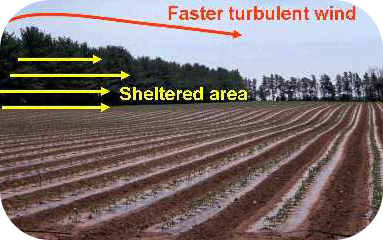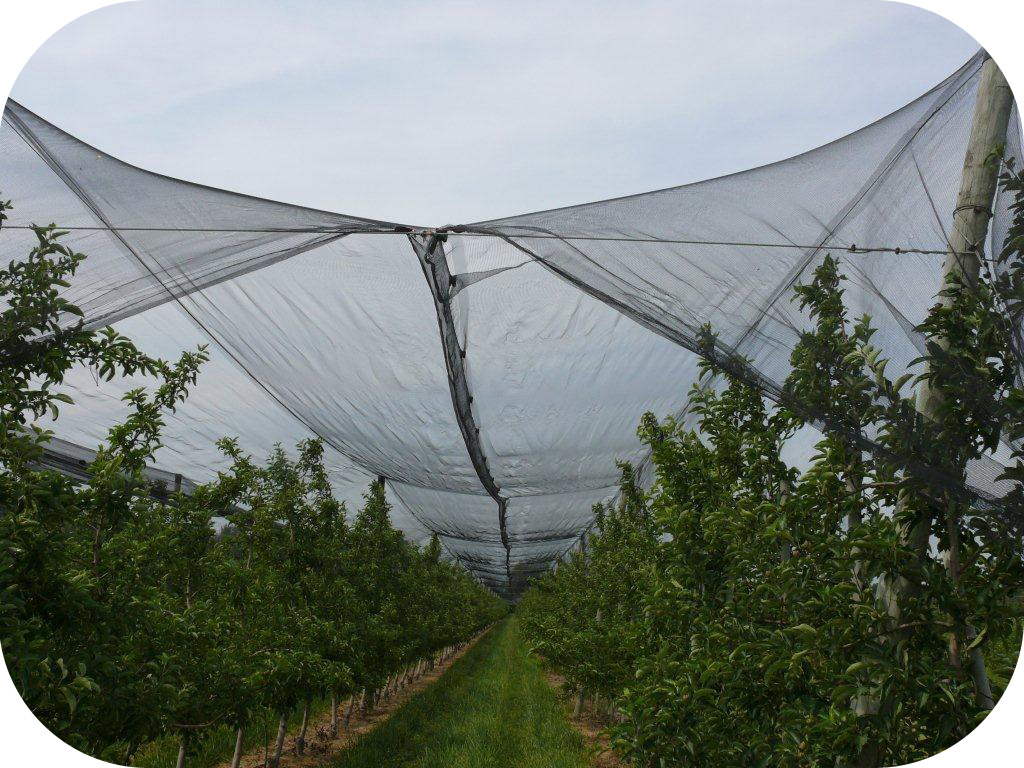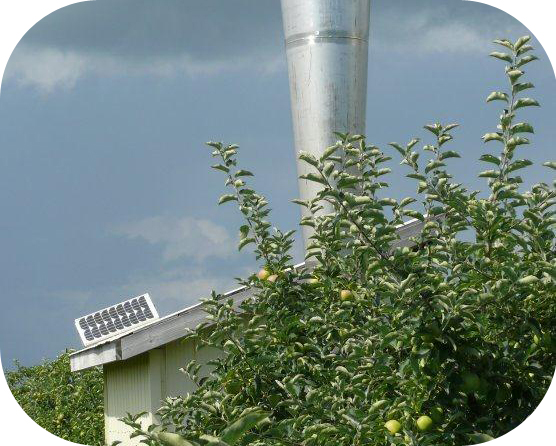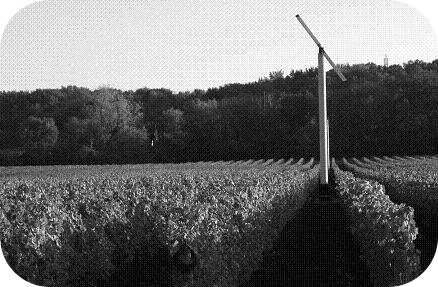Managing weather risks
Table of Contents
- Introduction
- Too much water
- Too little water
- Wind
- Hail
- Intense sunlight
- Winter injury
- Frost
- Additional Information
Weather has influence on many aspects of the business of growing tree fruit, as growers are well aware. When warm temperatures were pushing bud development in March of 2012, every grower knew there were risks from frost if the buds pushed into flower development. Some growers invested in frost protection strategies, with results ranging from promising to discouraging. Many are now considering future investments into frost protection. However, there are many weather risks in growing tree fruit in Ontario - which is the most critical for your particular orchard location?
Consider the risk to your orchards from these weather risks:
Too much water:
Ontario weather patterns usually create this problem in the spring and fall only. However, in 2011 many orchards dealt with excessive water throughout the entire year. Apples, peach and pears do not like "wet feet", although some newer rootstocks are more tolerant of imperfect drainage and subsequent Phytophthora infections. Tree roots standing in water-logged soils during the growing season are at much greater risk than when trees are dormant. Wet soils or potholes also make it challenging for spray or harvest equipment access. Rain close to harvest can cause cracking in sweet cherries.
Potential solutions:
- Installation of systematic tile drainage before planting the orchard;
- Use of "French drains" to direct surface water down to tile drains
- Choice of rootstocks tolerant of Phytophthora
- Use of cover crops before and during plantings to improve soil structure and drainage
- Avoidance of imperfectly-drained sites, especially clay soils.
- Use of tunnels to reduce cracking in cherries.
For more information:
- Drainage Guide for Ontario - Publication 29
- Drain Problems
- Tile Drainage Outlets
- Licensed Drainage Contractors (as of November 2012)
- Growing Sweet Cherries under High Tunnels in Michigan
- Effect
of water on apple trees: not enough or too much
Too little water:
Rainfall is often insufficient during the growing season to maintain tree health and to produce adequate yields and quality fruit. Water needs of fruit trees are increased under intense sunlight, and incoming solar radiation has been gradually increasing in recent decades. Dwarfing rootstocks have shallow root systems so are more susceptible to lack of rain.
Potential solutions:
- Supplemental irrigation, preferably a permanent trickle system
- Use of under-tree mulch to conserve soil moisture
- Addition of soil organic matter before planting with cover crops or other organic amendments
- Installation of subsurface tile drains which encourage deeper growth of roots, so this helps sustain trees through periods of drought.
For more information:
- Irrigating Tender Fruit
- Irrigation Scheduling For Fruit Crops
- BMP 08 - Irrigation Management (Revised 2004)
- Irrigation uniformity and efficiency - how to track what gets to the crop
- Drip Irrigation for High Density Orchards
- Low Water Conditions
- How to Prepare for Irrigation during water shortages
- Irrigating cherry orchards efficiently
- Effect
of water on apple trees: not enough or too much
Wind:
Every year brings severe weather, which often includes strong winds. Wind can cause fruit damage from limb rubs, as well as limb breakage (including the tree leader), or worse, breakage of the graft union. Wind damage can also allow entry of diseases like fire blight. Wind can cause problems with spray coverage and pesticide drift. Tornadoes have caused extensive damage in Ontario apple orchards in the past few years.
Potential solutions:
- Location of windbreaks on windward side of orchards; trees will help protect up to 10 times their height away from the windbreak
- Orientation of rows along path of prevailing winds
- Support the trees (especially leaders) right from planting
- Maximize strength of row trellises, especially the anchors
- Prune trees to allow space for apples to hang away from branches
- Summer prune to remove branches that may cause limb rubs
For more information:
- Windbreaks for Horticultural Crops
- Designing and Caring for Windbreaks
- Managing farm windbreaks to reduce frost injury
- Are Windbreaks Multifunctional?
- Windbreak trees that tolerate road salt spray drift
Hail:
The devastation from a short episode of hail has been felt by most tree fruit growers at some time. Hail can either bruise or cut fruit, starting at calyx until harvest. Hail cuts can also allow fire blight infections in leaves and bark (pears and apples) that can lead to death of trees, or removal of limbs.
Potential solutions:
- Hail netting, most useful for high value cultivars
- Hail interruption machines, like cannons, including weather monitoring system on a 24-hour basis
- Production insurance to cushion the economic impact
- Multiple locations of orchards to spread the risk
For more information:
- Ontario CropIPM: Hail
- Ontario CropIPM: Fire Blight - Shoot & Trauma
- Pest management guidelines for hailed and frosted orchards
- Bird Netting Suppliers (Partial List)
Intense sunlight:
Fruit growers in many parts of the world suffer damage from sunlight. UV radiation can cause sunburn on fruit, and sub-lethal injury on leaves. Intense sunlight can cause photosynthesis to slow down or stop, resulting in less manufactured carbohydrates, which can reduce yields and fruit quality.
Potential solutions:
- Use of sunscreen materials like kaolin clay
- Encouragement of leaf growth over fruit to prevent sunburn
- Use of evaporative cooling during the heat of the day (with caution)
For more information:
- Preventing Heat Stress and Fruit Sunburn on Apple and Pear Trees
- Ontario CropIPM: Sun Burn/Sun Scald
- August - Time for Pruning Apples?
Winter injury:
Although pears can tolerate colder air temperatures than most tender fruits, they can be damaged by sudden air temperature drops in the fall or very deep cold in the winter. The trunks and limb crotches are the last tissue to harden off in the fall, so may be vulnerable to air temperature changes in November and December. Extreme cold air temperatures, especially after January when trees start to deacclimate, may result in fruit bud damage or dead shoot tips. Infections from powdery mildew also make shoots most vulnerable to cold injury. Peaches and other stone fruits can be very vulnerable to temperature drops.
Potential solutions:
- Avoid cold sites
- Apply nitrogen only early in the season
- Grow sod or cover crops between rows after July to encourage trees to harden off
- Do not prune in the fall, or early winter
- Use reflective white paint on young tree trunks to avoid southwest injury
For more information:
- Apple Trees Get Ready for Winter Cold
- Evaluating tree fruit bud damage
- Low Temperature Injury and Wood Rot in Apple
- Control of Southwest Injury on Fruit Trees
- Winter Rest and the Breaking of Dormancy in Fruit Trees
- Winter Hardiness Starts Long Before the Snow Flies
- Wind Machines for Minimizing Cold Injury to Horticultural Crops
Frost:
Orchard site and location have a huge influence on the risk from frost. Many orchards are located near the Great Lakes, which tends to slow development in the spring, and delay bloom. Some orchards near Lake Ontario and Lake Erie had full crops in 2012 thanks to this lake effect. However, there were other orchards that were not as lucky. Rolling topography and high elevation are usually beneficial. Location of windbreaks to avoid frost pockets is important as well.
Potential solutions:
- Frost machines to either mix warm air from an inversion (eg. tower fans, tractor-mounted moveable units), or move cold air upwards to prevent ice crystal formation (eg. cold air drains);
- Burning hay bales to create a smoke layer (smudge effect):
- Frost protection with irrigation at low rates; orchard heaters.
For more information:
- Wind Machines for Minimizing Cold Injury to Horticultural Crops
- Es tu pret?
- Reducing frost damage in tender fruit and grapes
- Freeze Protection Methods For Crops
- Frost Protection Methods in Michigan-Costs and Considerations
- Principles of Frost Protection
The frosts of 2012 will only be one of the many weather-related stories for our industry. Be sure to carefully consider all of your weather risks before choosing which mitigation strategy will provide you with the most protection and returns.
FOR MORE INFORMATION:
Strategies to Mitigate Weather Risks









